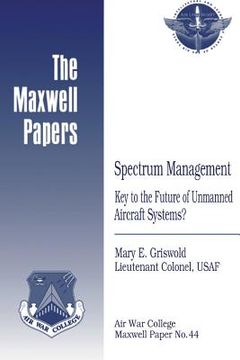Spectrum Management: Key to the Future of Unmanned Aircraft Systems?: Maxwell Paper No. 44 (in English)
Synopsis "Spectrum Management: Key to the Future of Unmanned Aircraft Systems?: Maxwell Paper No. 44 (in English)"
Today's military operations depend on a very large number of systems to acquire and process critical information needed by combatant commanders to accomplish their mission. Intelligence, surveillance, and reconnaissance systems often provide a much-needed picture that is vital to decision makers. Requests from commanders for information provided by unmanned aircraft systems (UAS) are growing so fast that they are outpacing system availability. The future of these aircraft is of such importance to military operations that in September 2007, Deputy Secretary of Defense Gordon England directed the establishment of a task force to coordinate UAS issues and determine a way ahead in order to resolve differences between the military services and their approaches to these systems. While the services continue to debate the advantages of one UAS over another or attempt to determine which service would best be able to manage its future, current operations are affected by the challenges caused by inadequate frequency spectrum and bandwidth availability. The most recent Department of Defense UAS road map (August 2005) lists problem areas highlighted by combat operations, including the lack of communications frequencies. Furthermore, a Defense Science Board report identifies constraints on communication bandwidth as an area needing more attention and new development. As UAS capabilities become even more sought after and as the number of these aircraft increases, something must be done to help ensure that the much-needed capabilities they provide are available to war fighters. One of the most critical major UAS subsystems, communications, allows information to be passed between the aircraft and its ground elements or to other airborne assets; it also enables a UAS to be guided and controlled from virtually anywhere at any time. Bandwidth is needed to support the systems providing data to control the vehicle in flight, including its launch and recovery, and to send data from the onboard sensors or payload to processing centers. Communications systems are the key to the operations of these aircraft and to the successful accomplishment of their missions. Moreover, the ability to pass needed data between components of the systems depends upon available frequencies and adequate bandwidth to move the data as quickly as possible. Technology promises to offer solutions to a number of these challenges, but it is not the only answer for spectrum and bandwidth availability. Other possible solutions include acquiring additional spectrum resources, making changes to acquisition processes, and developing better management tools and processes capable of helping alleviate current difficulties. In this paper, Lt Col Mary E. Griswold discusses the basics of the electromagnetic spectrum and UAS operations, pointing out how frequency management and bandwidth availability are key to UAS operations. She illustrates this through examples of difficulties encountered during military operations with spectrum and bandwidth issues. Finally, she notes that solutions to the current challenges are found in the employment of both short- and long-term actions in these areas to improve and optimize the use and availability of spectrum support for UAS operations in the future.

